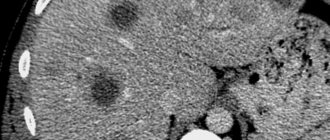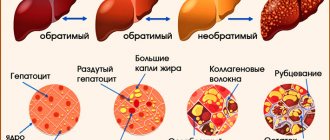Why is there no and cannot be a clear answer to the question of how long do patients with stage IV cancer live? What determines the life expectancy of a patient with this most advanced stage of cancer? We asked this question to a doctor of the highest category, head of the scientific department of innovative methods of therapeutic oncology and rehabilitation of the Research Institute of Oncology named after. N.N. Petrova, Doctor of Medical Sciences Tatyana Yuryevna Semiglazova.
Cancer cells are a person’s own cells over the growth and reproduction of which the body has lost control.
The evolution of cancer has 4 stages - 4 stages, each of which is usually designated by Roman numerals from I to IV. Detection of a tumor at a stage when metastases have already appeared in distant lymph nodes and/or tissues and organs automatically determines the stage of the process as the fourth.
What affects the life expectancy of a patient with stage 4 cancer?
The life prognosis of patients with stage IV malignant tumor is determined by the rate of tumor spread to surrounding tissues and distant organs.
Case study. In 1997, under the leadership of Professor Mikhail Lazarevich Gershanovich, we treated a patient with stage IV non-Hodgkin's lymphoma. The sick husband asked us how long his young wife had left to live? After polychemotherapy and radiation therapy for the remaining lesions, the patient has been coming to see me for 20 years in full health, and her son successfully entered the University.
In some cases, concomitant diseases (severe diabetes mellitus, chronic decompensated heart failure, respiratory or renal failure, cerebrovascular and thromboembolic diseases, chronic infections, etc.) sharply aggravate the patient’s life prognosis, which prevent full treatment.
Paradoxes of age
There is an opinion that it is more difficult for older people to fight a disease called cancer. After all, a large number of concomitant diseases limits the use of certain types of treatment, due to the risk of developing various complications. On the other hand, in older people, metabolic processes are slowed down, and the course of the disease itself is inactive and sluggish. It is important to remember that today elderly and senile age is not in itself a contraindication to the prescription of antitumor drug therapy. The biological age of the patient is more important, and not the one indicated in the passport.
In young patients, on the contrary, the number of concomitant diseases is several times less, and there may be no serious ones at all. But active metabolic processes may partly contribute to the aggressive course of the tumor. So age becomes both an ally and an enemy.
The duration of the anamnesis (history) of the disease, as well as the reserves of antitumor treatment, are of great importance.
Everything depends on a number of important factors, the main one of which is the tumor passport, which is determined by the results of histological, immunohistochemical + molecular genetic findings.
Antitumor treatment for stage IV cancer today may include:
- all types of drug antitumor therapy (chemotherapy, hormone therapy, targeted therapy, immunotherapy, immunoconjugates);
- accompanying therapy (osteomodifying agents, for example, bisphosphonates or denosumab, drug prevention of the most common complications of chemotherapy: nausea and vomiting, neutropenia and anemia, etc.);
- radiation therapy, primarily for analgesic purposes;
- cytoreductive surgical treatment (aimed at reducing the volume of tumor masses);
- local physical methods - photodynamic therapy, cryodestruction, etc.;
- symptomatic therapy (aimed at correcting various symptoms of the disease) - analgesic, sedative, correction of nutritional deficiency, etc.
Therefore, tumors are divided into 3 main groups:
- Highly sensitive to chemotherapy, which can be cured with its help (germ tumors, hydatidiform mole, Hodgkin's lymphoma, etc.).
- Tumors that respond to chemotherapy, but are not completely cured (non-Hodgkin's lymphoma, breast cancer, small cell lung cancer, ovarian cancer, etc.).
- Tumors that do not respond well to chemotherapy, such as stomach cancer, liver cancer, pancreatic cancer, melanoma, etc.
Laboratory of Molecular Oncology
Among patients with stage 4 cancer, palliative patients should be especially emphasized.
The stage when a palliative patient experiences severe weakness, does not get out of bed and does not move independently, does not eat, and has confusion is called thermal. All possible types of treatment have already been tried and have stopped working; only symptomatic help is possible (for example, pain relief). The cause of death in cancer patients is often multiple organ failure. The tumor inhibits the functions of important organs and systems of the body, the tumor mass grows and becomes incompatible with life. However, patients with stage 4 cancer who receive competent palliative care, which is currently provided in full by qualified and specially trained HOSPICE staff, can live a long time and with a good quality of life. Every patient always has a chance to wait for new types of treatment to which the cancer will be sensitive. Science is moving forward by leaps and bounds!
What does psychological help provide to a cancer patient?
- The emotional state of patients and relatives improves;
- Anxieties, fears, and difficulties in family relationships are overcome;
- motivation to undergo treatment is strengthened;
- the quality of life of patients and their family members improves;
- skills of effective communication with medical staff, colleagues, friends and loved ones are acquired.
Lung cancer stage 4: symptoms before death, how do they die and what do they feel?
In general, the process of death from cancer occurs sequentially in several stages.
Predagonia. At this stage, significant disturbances in the activity of the central nervous system are observed. Physical and emotional functions decline sharply. The skin turns blue, blood pressure drops sharply. Agony. At this stage, oxygen starvation occurs, as a result of which breathing stops and the blood circulation process slows down.
Such pre-death symptoms are typical for all cancer patients. But these symptoms can be supplemented by other signs, which depend on which organs are affected by cancer.
During this period of disease development, all treatment procedures are aimed at improving the patient’s general health and reducing the likelihood of death. It is noteworthy that the last stage of stomach cancer cannot be completely cured.
The fourth cancer and its treatment methods:
- carrying out surgery. Doctors usually resort to surgery as a last resort. Palliative surgeries are usually performed, which are aimed at alleviating the patient's health condition. However, this method cannot stop the malignant process. With the help of surgery, normal intestinal patency can be restored to the patient. In some cases, some damaged area of the stomach may be removed. This also improves the patient's health, but does not completely remove the cancerous tumor; implementation of laser therapy. It is characterized by the impact of special rays on a cancerous tumor. This helps restore normal gastric patency. Patency can also be restored by introducing a special tube into the patient’s body.
It is noteworthy that surgery and laser therapy can be prescribed by a specialist if the cancer process has not affected the peritoneal area and depletion of the body has not occurred. If this happens, then the operation is not prescribed. In this case, due to health reasons, the patient will not be able to tolerate it.
- Carrying out chemotherapy. It is aimed at introducing special drugs that have a negative effect on cancer cells. This method helps reduce the size of the cancer tumor. It is usually used in preparation for or after surgery. 5-fluorouracil and cytostatics are used as special drugs. It is noteworthy that the use of foreign medicines is not capable of causing side effects. This is their main difference from domestic drugs.
In order to achieve the best effect, chemotherapy is usually carried out in combination with radiation therapy. If the patient’s body is excessively exhausted, this method is not used. This is due to the fact that its use can lead to a sharp decrease in the activity of the immune system.
- implementation of palliative therapy. It aims to improve the patient's quality of life and general health. With it, the patient receives all the necessary medications that help reduce inflammation and the impact of negative symptoms. Typically, this therapy is carried out in combination with hormonal and immunomodulatory drugs.
To achieve a better effect, many patients combine drug therapy with the use of traditional medicine.
- Predagonia. At this stage, significant disturbances in the activity of the central nervous system are observed. Physical and emotional functions decline sharply. The skin turns blue, blood pressure drops sharply.
- Agony. At this stage, oxygen starvation occurs, as a result of which breathing stops and the blood circulation process slows down. This period lasts no more than three hours.
- Clinical death. There is a critical decrease in the activity of metabolic processes, all body functions suspend their activity.
- Biological death. The vital activity of the brain stops, the body dies.
note
Every third cancer patient is diagnosed with the disease at its most severe stages.
When a cancerous tumor is already “in bloom” and gives many metastases, destroying organs, causing bleeding and tissue decay, the pathological process becomes irreversible. Doctors can only slow down the course of a fatal disease by providing symptomatic treatment, as well as provide the patient with psychological comfort.
There is a general symptomatic picture that describes how a cancer patient dies.
The process of dying of the body depends on the type of cancer, its location, and also on the rate of growth in the tissue. Cancer cells occupy more and more free space and absorb increased amounts of nutrients. As a result, healthy organs are not able to function fully.
Cancer can spread to the stomach, pancreas, colon, etc. Due to this, food or waste is unable to pass through the digestive system, causing bloating, nausea or vomiting. This condition leads to the fact that food is not digested, and the patient is unable to receive the necessary amount of food to continue the life cycle.
Damage to bone tissue cancer provokes the release of calcium into the general bloodstream, which can lead to loss of consciousness and death. Also, bones with tumors break and do not heal.
You should pay attention to the following symptoms:
- progressive weakness and exhaustion. These conditions are so strong that the patient spends most of his time in bed;
- weight loss and muscle atrophy;
- minimal appetite and difficulty swallowing food;
- decreased ability to speak and concentrate;
- loss of interest in the outside world and things that were previously important;
- a person’s desire to limit the number of people around or reduce the time for visits.
Important to know: Nutrition for cancer patients: 11 most important foods
In modern medicine there is no effective therapy for malignant lung tumors. If in the early stages there is still a chance for recovery, then at stages 3 and 4 the disease progresses so rapidly that it is no longer possible to stop it.
What is the disease
A malignant tumor of the stomach in most cases is formed by epithelial tissues that line its mucous membrane. This type of tumor is called adenocarcinoma. In addition, other types of cancer are registered, which, according to the WHO classification, are divided into the following:
- signet ring cancer, consisting of vesicular signet ring cells and having a hormonal nature - in women and men in this case there is an increase in the level of the corresponding sex hormones;
- papillary cancer formed by papillary structures with the inclusion of a cystic component;
- tubular cancer, growing from columnar epithelial cells;
- mucinous cancer with a mucous structure.
Scheme of one of the variants of localization of a malignant tumor in the stomach
There are also more detailed classifications that, in addition to the above types of stomach cancer, also consider the following:
- ulcerative and pseudo-ulcerative, simulating a traditional gastric ulcer in form and course;
- infiltrative, without a clearly defined border and growing deep into the gastric wall;
- polypoid, i.e. shaped like polyps;
- scirri are invasive tumors of an aggressive nature, occupying large spaces of the organ both in breadth and depth;
- adenosquamous and squamous - squamous cell neoplasms with and without signs of keratinization, respectively.
In accordance with the international TNM system, where T - tumor (tumor), N - nodes (lymph nodes), M - metastasis (metastasis), stage 4 gastric cancer is indicated by the formula: T any, N any, M1, which means any size of the tumor, any variants of tumor spread in the lymphatic system and the presence of distant metastases in other organs.
In stage 4 stomach cancer, the tumor metastasizes to distant organs
At the 4th stage of stomach cancer, invasion (spread) of cancer cells occurs through the blood and lymphatic vessels, as a result of which vital distant organs are affected - the liver, lungs, kidneys, and skeleton.
Life expectancy at stage 4 for stomach cancer: survival prognosis and influencing factors
How long people live with stage 4 stomach cancer depends on the individual physiology of a person, his age and gender, as well as on the care and attention of the people around him and the type of therapeutic drug support. As a rule, the survival prognosis for stage 4 gastric cancer is unfavorable. In 90% of cases, rapidly developing cancer in the stomach is fatal within 3-5 years after diagnosis. However, practical gastroenterology knows cases where people live with stage 4 stomach cancer for more than 10 years, which is a rare exception to the rule.
According to medical experts, it is impossible to give an unambiguous prognosis for survival for stage 4 stomach cancer.
Causes and factors for the development of pathology
First of all, it should be noted that malignant tumors do not arise in a healthy stomach - they must be preceded by certain pathological processes. Among these precancerous conditions:
- chronic gastritis;
- polyposis and other benign neoplasms of the gastric mucosa;
- peptic ulcer caused by the bacterium Helicobacter pylori;
- dysplasia of the gastric walls.
This is how malignant degeneration (malignization) of the polyp occurs
In addition, there are a number of factors that contribute to the development of stomach cancer. These include:
- consequences of gastric surgery;
- hereditary predisposition;
- unhealthy diet (excessive consumption of salt, carcinogenic food additives and preservatives, abuse of alcohol, marinades, spicy and smoked foods);
- uncontrolled use of medications - aspirin, steroid drugs, etc.;
- deficiency of vitamin C and E, which affects the condition of the mucous membrane;
- the presence of infections in the body - staphylococcal, fungal, herpes.
Main reasons
A common cancer is stomach cancer. A malignant transformation of epithelial tissue cells occurs and the walls of the stomach are affected. The exact causes of the tumor have not been established. But the chances of getting sick increase if the following factors are present in a person’s life:
- alcohol, smoking;
- unhealthy food;
- obesity;
- polluted environment;
- chemical work;
- improper drug treatment;
- infection with Helicobacter Pylori bacteria.
To prevent cancer, you need to be attentive to your health by following the rules:
- visit a doctor regularly;
- take biochemistry and general blood tests;
- treat precancerous acute and chronic stomach problems appropriately and in a timely manner;
- eat a balanced diet;
- do not abuse alcohol and smoke.
Return to contents
Symptoms of the disease
If at the initial stages of cancer development there are practically no manifestations, then by the 4th stage stomach cancer manifests itself quite clearly. Symptoms can vary significantly depending on the location of the tumor. The location of the tumor in the cardial part of the stomach (closest to the esophagus) most often simulates cardiovascular diseases, for example, coronary heart disease, and a tumor localized in the antrum of the organ (at the exit from the stomach) - pathologies of the gastrointestinal tract, such as gastritis, pancreatitis, etc.
Pain in the epigastric zone is one of the symptoms of stomach cancer
The main symptoms of cancer of the stomach are:
- feeling of constant discomfort in the epigastric zone;
- pain in the stomach that does not go away after eating and is not relieved by conventional analgesics;
- lack of effect from standard treatment of gastrointestinal disorders;
- difficulty swallowing food;
- nausea after eating, possibly with vomiting;
- lack of appetite, aversion to meat products;
- significant weight loss;
- increased fatigue, weakness, anemia;
Frequent nausea and vomiting are symptoms of stomach cancer
When the tumor begins to disintegrate, perforation of the gastric wall occurs, in which the contents of the organ enter the abdominal space, causing the development of peritonitis. In this case, acute symptoms develop that require immediate surgical care:
SYMPTOMS
There are no nerve endings in the lung tissue, so 26% of healthy tissue is enough to ensure normal breathing. Therefore, with this fact, the first symptoms of a terrible disease do not bother the patient, but they are difficult to diagnose. The spread of the tumor can continue freely without disturbing the patient; people live with the tumor for more than a year. In this case, symptoms common to many diseases are observed:
- decreased activity and performance;
- fast fatiguability;
- weakness;
- depressed state;
- rare dry cough.
Further growth of cancer is often mistaken for bronchitis, pneumonia, viral infections, and pneumonia. At the same time, new symptoms appear. The temperature periodically rises, which is temporarily reduced by medications, but then reappears. How long can this condition last? Doctors say that for several months a person will find different reasons for his poor health. At this stage of the disease, it is almost impossible to associate the symptoms with cancer. At the second or third stage, symptoms characteristic of lung cancer appear:
- dyspnea;
- pulmonary failure;
- arrhythmia;
- chest pain, usually on the side where the tumor is progressing;
- coughing attacks intensify, bloody discharge appears in the sputum;
- causeless weight loss;
- Difficulty swallowing, making it difficult for food to pass through the esophagus.
It is not uncommon for patients to live with a tumor for a long time, and only in the last stages do they pay attention to the disease, when lung cancer metastasizes to other organs (stage 4 cancer). Then they turn to a cardiologist, ophthalmologist, orthopedist or other highly specialized specialists for help, without understanding the true cause of the disease.
Basic diagnostic methods
The main task of diagnosis in this case is differentiation from diseases that have similar symptoms - atrophic gastritis, peptic ulcer, polyposis, angina pectoris and a number of infectious diseases (syphilis, tuberculosis, amyloidosis).
| Diagnostic method | Contents of the diagnostic method |
| Physical | analysis of patient complaints |
| assessment of its appearance and condition | |
| examination of the condition of lymph nodes localized in areas of possible metastasis | |
| percussion of the heart area to exclude ischemic heart disease | |
| Instrumental | esophagogastroduodenoscopy - an internal examination of the esophagus, stomach and pancreas using a fiber optic probe to detect a tumor and take tissue samples |
| Ultrasound is performed in several ways: through the abdominal wall without filling the stomach with liquid and with filling, as well as using an endoscopic probe (not to be confused with a fiber optic probe). The method allows you to examine the condition of organs and adjacent lymph nodes | |
| X-ray of the stomach with a contrast agent - gives an idea of the exact localization of the tumor and defects in the stomach wall | |
| CT and MRI - the main task of diagnosis is not so much the detection of a tumor, but the presence of distant metastases in other organs | |
| laparoscopy - a study that allows you to assess the degree of operability of a tumor | |
| Morphological | cytological examination of the material taken, establishing the nature of cancer cells and the degree of their differentiation, and therefore malignancy |
| Laboratory | blood test (including tumor markers SA and CEA), lymph, gastric juice |
How is diagnostics carried out?
Due to the fact that the patient is bothered by unpleasant symptoms, stage 4 cancer is very well detected.
Additional diagnostic methods are:
- carrying out physical diagnostics. This stage is carried out by palpation of the problem area. With it, a specialist identifies seals in the area of the anterior abdominal wall;
- performing X-ray diagnostics;
- performing endoscopy. It involves collecting biomaterial from several areas of the stomach;
- implementation of ultrasound diagnostics. It is usually carried out through the abdominal cavity. The patient can also have a special probe installed;
- performing laparoscopy.
Typically, when stage 4 stomach cancer develops in a patient, the doctor diagnoses the following unpleasant signs:
- close location of cancer cells near neighboring organs;
- spread of the tumor to neighboring lymph nodes;
- spread of cancer to nearby organs.
Treatment
In most cases, stage 4 gastric cancer is considered inoperable and treatment of the disease is aimed at ensuring the patient’s quality of life, i.e. is palliative in nature.
The use of traditional medicine for stage 4 stomach cancer, unfortunately, is not able to help alleviate the patient’s condition, much less influence his cure.
Surgical removal of the tumor in the 4th stage of the disease is performed for health reasons. For example, endoluminal stenting is performed to restore the lumen of the stomach so that the patient can eat food, or an anastomosis is performed - an artificial fistula through which food can enter the patient’s body.
Gastrostomy - the formation of an anastomosis (artificial fistula), through which the patient can receive food
In addition, palliative removal of at least part of the tumor makes it possible to reduce its size and thus reduce the toxic effect on the patient’s body, which will undoubtedly alleviate his condition.
Palliative operations increase the effect of subsequent chemotherapy and radiation, thereby stabilizing the disease and increasing the patient's life expectancy.
In case of inoperable stomach cancer, palliative treatment is carried out - radiation therapy and treatment with cytostatics - Doxorubicin, Cisplatin, Mitomycin, Cyclophosphamide and other chemotherapy drugs. Both chemotherapy and radiation cause serious complications on the patient’s body, but at the same time suppress the development of a malignant process in the body. The doctor prescribing such treatment must, of course, weigh the possible benefits from it with the harm caused.
Immunotherapy used in the treatment of stage 4 gastric cancer can be carried out in three options:
- The use of vaccines prepared based on the biomaterial of a specific tumor;
- General immunotherapy aimed at activating the patient’s immune system;
- The use of monoclonal antibodies, i.e. clones created on the basis of a human cell (in the case of stomach cancer, these are antibodies designated by the code SU11248).
The latest innovative method is relatively new and has a number of significant advantages, including the absence of a negative effect on the patient’s body, already weakened by a serious illness. Unfortunately, some patients do not respond to such treatment because they develop resistance to this type of therapy, but scientists do not stop looking for a solution to this problem and already have some success.
Esophageal carcinoma
Esophageal cancer is a very dangerous disease. At the fourth stage of esophageal cancer, the tumor grows and affects all nearby organs. Therefore, pain symptoms can be felt not only in the esophagus, but even in the lungs. Death can occur from exhaustion of the body, since a patient suffering from esophageal cancer cannot take food in any form. Nutrition is provided only through a tube. Such patients will no longer be able to eat regular foods.
Before death, everyone suffering from liver cancer experiences great agony. They vomit violently, most often with blood. Sharp pain in the chest causes discomfort.
Esophageal cancer is a very dangerous disease. At the fourth stage of esophageal cancer, the tumor grows and affects all nearby organs. Therefore, pain symptoms can be felt not only in the esophagus, but even in the lungs. Death can occur from exhaustion of the body, since a patient suffering from esophageal cancer cannot take food in any form. Nutrition is provided only through a tube. Such patients will no longer be able to eat regular foods.
Companion diet
The main goals of the diet during the treatment of stage 4 gastric cancer are the following:
- weight loss compensation;
- mitigating the aggressive effects of therapy on the patient’s body;
- support and increase immunity;
- normalization of metabolism;
- activation of restoration processes in the body.
Nutrition for a patient with stomach cancer should be organized according to certain rules:
- food should only be boiled, baked, stewed, steamed;
- fractional meals are needed - small portions 5-6 times a day;
- the menu needs to be adjusted depending on the patient’s well-being and the period of treatment.
The following dishes are recommended for consumption:
- pureed soups (vegetable, dairy);
- soft-boiled chicken and quail eggs;
- dietary meats - chicken, rabbit, veal;
- lean fish;
- boiled porridge;
- cottage cheese;
- dried white bread;
- vegetable fats;
- butter in limited quantities;
- fruit and berry jelly.
Fatty, fried, spicy, salty, smoked foods, strong tea, coffee, alcoholic and carbonated drinks should be excluded from the diet. In addition, any hot food is contraindicated for the patient.
Featured products (gallery)
Foods to exclude from your diet (gallery)
If the patient does not have edema, he is advised to drink juices, since with stomach cancer the body constantly loses a lot of fluid due to frequent vomiting and gastric bleeding, and juices, among other things, in addition to restoring fluid balance, help solve a number of problems:
- saturating the body with natural vitamins and minerals;
- increased acidity of gastric juice;
- decreased gag reflex;
- improvement of intestinal motility;
- activation of appetite.
For patients with stomach cancer, freshly squeezed juices are recommended
It is better to consume freshly squeezed juices with pulp. The following vegetables, fruits and berries are most suitable for making fresh juices:
- beets, carrots, tomatoes, cabbage, paprika, celery;
- pears, apples, quince, pomegranate, apricot;
- black and red currants, cherries, cranberries.
Stages of lung cancer 1,2,3, 4 stages, symptoms, signs, prognosis, treatment
One of the leading causes of death in the world is lung cancer, the symptoms of which vary depending on the stage of the disease. The development of a cancerous tumor is promoted by both external factors and internal causes. But, regardless of the treatment, the likelihood of recovery remains low.
Lung cancer is a malignant tumor that develops from the mucous membrane and glandular tissue of the lungs and bronchi. Men are more susceptible to this disease than women, and it has been noted that the older the men, the higher the incidence rate. The risk group includes men with dark skin color.
Symptoms characterizing the development of a cancerous tumor in the lungs are divided into two categories: general and specific.
- All information on the site is for informational purposes only and is NOT a guide to action!
- Only a DOCTOR can give you an ACCURATE DIAGNOSIS!
- We kindly ask you NOT to self-medicate, but to make an appointment with a specialist!
- Health to you and your loved ones! Do not give up
The first category of common symptoms includes:
- general weakness of the body;
- deterioration or loss of appetite;
- rapid weight loss;
- sweating;
- causeless change of mood;
- development of depression;
- increase in body temperature.
The second category of specific symptoms includes factors such as:
- an unreasonable cough that can last for some period, exhausting the patient. The nature of the cough may gradually change, become more frequent and prolonged, and be accompanied by sputum production.
A cough can appear spontaneously: it is enough to breathe in cold air, experience prolonged physical activity, or simply walk at a brisk pace.
shortness of breath also indicates changes present in the lungs. It is associated with a narrowing of the lumen of the bronchi, impaired ventilation (atelectasis), developed pneumonia, partial or significant impairment of gas exchange in the lungs.
In the later stages of the disease, atelectasis (impaired ventilation) of the entire lung and its failure may occur.
hemoptysis, which is a characteristic sign of lung cancer. The quality of the bloody discharge may vary: it may be active bleeding or the discharge of dark blood clots. It depends on the stage of the disease, the shape and histological features of the tumor.
In some cases, hemoptysis may indicate the development of pulmonary tuberculosis or bronchiectasis. Often heavy and prolonged bleeding leads to death.
pain behind the sternum, which is evidence of tumor growth into the pleura, later into bone tissue and nerve endings. This process is accompanied by characteristic unbearable pain in the chest area.
With some forms of lung cancer, there are no early symptoms of the disease. This significantly complicates the detection and diagnosis of tumors in the early stages. This means they reduce the patient’s chance of recovery.
: Unusual signs of lung cancer
Disease prognosis
Not so long ago, the five-year survival rate of patients with stage 4 gastric cancer did not exceed 5%. Today, thanks to new methods of therapy, this figure has increased significantly and is 18–20%. When talking about the prognosis of the disease, it is necessary to take into account the patient’s age, the condition of his body, the nature of the malignant neoplasm and its location, and the prevalence of distant metastasis. In addition, the patient’s psychological attitude towards a positive result plays a huge role.
Liver cancer
The main cause of liver cancer is liver cirrhosis. Viral hepatitis is another disease that leads to liver cancer.
Death from liver cancer is very painful. The disease progresses quite quickly. In addition, pain in the liver area is accompanied by nausea and general weakness. The temperature rises to critical levels. The patient experiences excruciating suffering before the onset of imminent death from liver cancer.
Liver cancer
Doctors talk about stomach cancer (video)
Stage 4 stomach cancer is a difficult diagnosis, and the treatment process is also not easy, exhausting work, but even after learning the whole truth about your illness, do not rush to give up on yourself. Innovative technologies introduced into treatment practice in recent years, cooperation with a doctor and faith in the result will help extend life for years, and for this it is worth fighting and winning!
A malignant tumor has four stages of development. As for stage 4, it is the last, dangerous, and has disappointing prognosis. Gastric cancer of the last stage is manifested by an increased increase in general, specific symptoms of the disease. In the previous three stages there are no specific signs, sometimes they do not make themselves felt at all. This causes delays in seeing a doctor. As a result, the final degree of malignancy occurs. Gastric carcinoma has an ambiguous prognosis, which depends on the symptoms present. According to statistics, 1 out of 20 patients lives for five years after the disease.
How long do patients with stage 4 gastric cancer with metastases live?
Gastric cancer goes through 4 stages in its development, just like any other cancer. Unfortunately, the disease is often diagnosed already at the last, fourth stage, when it is almost impossible to achieve recovery of the patient, but this does not mean that modern medicine is not able to help the patient, alleviate his condition and prolong life for years.
Doctors note that life expectancy for this disease is about 1-5 years. It is noteworthy that the disease appears in people over 50 years of age. Doctors also note that life expectancy for stomach cancer also depends on the following factors:
- age and general health of the patient;
- on the type of disease being spread;
- from the presence of metastases in neighboring organs;
- from the general psychological state of the sick patient.
Thus, stomach cancer is a very dangerous disease, from which almost no person is immune. But to reduce the likelihood of its occurrence, doctors recommend that all people undergo a comprehensive examination of the body, eat only the right foods and completely give up bad habits.
This will help the patient, if unpleasant symptoms appear, to contact a specialist in time and begin competent treatment. Also, following these simple rules will help reduce the likelihood of this unpleasant disease and live a long and happy life.
Specifics of the clinical picture
Stage 4 of stomach cancer is characterized by the release of malignant cells from the digestive organ, as well as germination in neighboring systems and organs. A fourth stage tumor can spread far from the stomach.
Such tumor growth is accompanied by the formation of metastases. In rare cases, the disease ends in recovery after surgery. Chemotherapy, radioactive irradiation, radical therapy, most often, are unable to significantly prolong the patient’s life. The course of the disease and the prognosis for recovery largely depend on the characteristics of the body. After treatment for stage 4 stomach cancer, patients can live from several months to 3–5 years.
With metastases, intense clinical signs appear that do not make themselves felt in the early stages.
In stage 4 stomach cancer, carcinoma is observed, which is manifested by a feeling of fullness after a small amount of food. There is a noticeable increase in the lymph nodes in volume, they are painful to touch. Disorders of the gastrointestinal tract extend to all internal organs and systems.
A patient with stomach cancer complains of nausea and vomiting, severe pain, heartburn, defecation disorder and intestinal obstruction. Specialists identify metastases in the liver, lungs and intestines, ovaries, lymph nodes, bones and brain.
The prognosis for treatment of stage 4 gastric cancer depends on the individual characteristics of the body, the progress of the disease, the effectiveness of resection and chemotherapy. Symptoms manifest differently, depending on the extent of development of the malignant neoplasm, as well as its type and shape.
The worst prognosis is for the infiltrative-ulcerative type of the disease, manifested by severe pain and fulminant development. Death occurs within two or three months. With gastric obstruction, vomiting occurs, weight loss occurs, and cachexia appears. Anemia develops very quickly, and there is lethargy, weakness and pallor of the skin.
We should not forget about the specific symptoms of a malignant tumor, namely the color of vomit and bowel movements. If the stool is black, this is a reason to differentiate this stomach cancer. The presence of this color is due to the presence of blood in the masses. The sooner treatment for stage 4 stomach cancer begins, the longer a person can live. There is an increase in the volume of the abdomen if metastases have affected the digestive system, namely the pancreas and liver. There are symptoms of body intoxication.
What are the symptoms of the last stage of stomach cancer?
The early stages of the disease often go unnoticed. However, at the last stage there are pronounced signs of the disease:
- regular and severe abdominal pain;
- vomiting like “coffee grounds” (black);
- sudden weight loss;
- heartburn;
- nausea;
- frequent hiccups;
- bloating;
- constant weakness;
- pale or sallow skin tone;
- dysphagia;
- painful, enlarged lymph nodes;
- black, “tarry” stools.
Individual manifestations of a progressive disease are determined by the degree and direction of growth, as well as the localization of the tumor:
- When a tumor grows inside the stomach, its volume decreases. In this regard, the patient begins to feel full after eating even small portions of food.
- When a tumor grows in the pancreatic tissue, discomfort appears in the back.
- If oncology has developed in the upper part of the stomach, then the patient experiences heart pain.
- When the esophagus is affected by a malignant tumor, dysphagia is aggravated.
- The spread of the tumor to the liver causes jaundice, itching, dry skin, and leads to ascites.
- In cancer of the antrum of the stomach, manifestations of pyloric stenosis predominate.
Important! The inability to eat or assimilate food at the last stage of the malignant process becomes the cause of progressive weakness and general exhaustion.











